The deployment and management of Notes/Domino has traditionally been divided between the Domino administration staff and the desktop management team. In previous releases, the deployment of Notes was a completely stand-alone process, and Domino administrators relied on the desktop team to deploy the client. Domino then introduced a feature called Smart Upgrade to assist with the management and deployment of new Notes client releases. This concept of server-based management of the client was significantly enhanced with the introduction of policies and enhancements to Smart Upgrade.
The task of managing the Notes client through Domino has been significantly enhanced in Notes/Domino 8. With the introduction of the Eclipse client platform for Notes, the Domino server becomes a provisioning tool. Advancements in policies and the introduction of the database redirect feature also significantly improve the ability to manage the Notes environment.
This chapter focuses on the new and improved technologies that allow Domino to better deploy and manage upgrades to the Notes client:
Client provisioning includes new features that leverage Eclipse client and server provisioning.
Policy enhancements include new and enhanced features within the policy document environment.
Database redirect is a new feature that allows you to better manage database access from the end user environment.
The shifting of Notes to the Eclipse platform has a significant impact on the end user community. As noted inChapter 2 of this book, the new look and feel of the client and the underlying Eclipse foundation enhances the end user environment. Eclipse-based plug-ins in Notes extend the user's ability to work in a collaborative environment. Unfortunately, the management of these new features may require a higher level of user interaction. Lotus/IBM has recognized this issue, and has leveraged the native Eclipse provisioning architecture to allow for the management of plug-ins and the desktop environment. The introduction of these provisioning features does not replace the Smart Upgrade feature; this utility can still be used to deploy versions of the client.
Domino 8 offers functionality that allows for the deployment of the full Notes client, Eclipse-based plug-ins, and applications (native Domino, composite, or Expeditor based). The following illustration shows the different models for managing the end user environment:
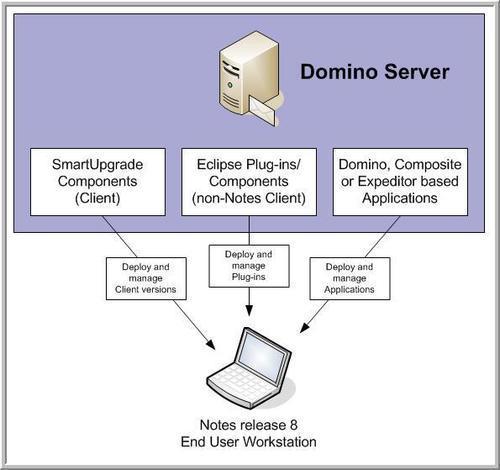
The traditional Smart Upgrade feature within the Domino server can be used to deploy Notes to the end users. The Smart Upgrade feature will assist in pushing the entire set of client code to the Notes user community.
For more information on the Smart Upgrade feature, refer to the Domino 8 Administrator Help database.
Notes 8 is built on the Eclipse foundation. Composite applications are considered as features within the Notes architecture, so their deployment and management is handled through the same process as other Eclipse-based features. The management of Eclipse-based clients such as Notes and Sametime Connect 7.5.x is now shifted to the native provisioning model. When the end user or administrator wants to push out a new feature to Notes, they will be directed to a Site.XML, which contains the information for installing the feature. The feature that is being installed within the Eclipse framework will have dependant plug-ins required for the feature to function properly.
Within Domino 8, a new update.ntf template leverages the native Notes replication and security features, to provide and manage access to new and updated features.
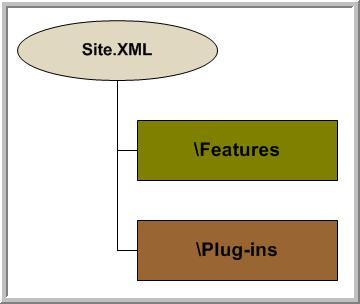
For more information on provisioning features through Domino, consult the Domino 8 Administrator Help database.
Policies were introduced in earlier releases of Domino to assist in the management of end users through a server-managed process. They are configured through the Domino Directory. Domino 8 introduces new policy documents, as well as new options within existing policy documents. This section will review these new and enhanced policies and options.

Note
It is important to note that Domino uses dynamic configuration to deploy all policy settings, with the exception of the mail policy settings. When end users authenticate with their home servers, the information stored within the policy settings documents is deployed (pushed down) to the end users. The mail policy settings are not deployed through the dynamic configuration process; instead they are deployed throughout the environment via the administration process (AdminP).
In previous releases of Domino, policies were applied to all end users who were configured to receive them. This was limiting, as it forced users to conform to the policies without the option of changing them later if necessary. The new How to apply setting option allows you to configure whether the policy is applied, using one of the following three options:
No policy, use default value: This option uses the initial configuration upon installation of the client.
Set initial value: This option sets the value for the end user, but does not prohibit the end user from later changing it to better suit current requirements.
Set value and prevent changes: This option sets the value for the end user and enforces the option so that the end user cannot make a change.
Lotus Connections does not require the use of Notes/Domino, but with the Eclipse platform, the Activities portion of the product can be leveraged as a plug-in to the client environment. To support this new product and the plug-in, Domino 8 contains a new Activities policy document to manage the Activities environment, specifically the ability to configure an Activities server URL and port. Additionally, you can specify whether or not SSL is leveraged to encrypt the username, password, and data.

The support of Open Document Format (ODF) has been extended to Notes/Domino through the introduction of productivity tools within the client. To support this new feature, Domino 8 contains a new productivities tools policy document. This can be used to leverage the tools and macros, and the ability to choose which Microsoft Office and SmartSuite files and templates to open by default.

To ease the management of the environment, the options for the setup policy settings document are now also available in the desktop policy settings document. You can now use just one document (the desktop policy settings document) to establish the desktop policy settings as well as many of the setup policy settings. It is recommended that going forward, you use the new, updated desktop policy settings document to define both your desktop policy settings and your setup policy settings.
The desktop policy settings document controls the user's workspace. Desktop settings are enforced the first time a user logs in to Notes and runs setup. After the initial setup, you can use the policy settings to update the user's desktop settings. Users receive updates to the settings when any of the policy settings change; the desktop policy settings are enforced the next time users authenticate with their home server.
As customers consolidate their Domino environments, the use of the local replication model is becoming more popular. Local replication allows end users to interact with their mail databases locally on their machines and to leverage the native asynchronous notification process to deliver mail to the workstation.
Deploying the local replication model is the key to the success of the consolidation project. With local replica-based mail, users perform all their mail functions in a replica stored on the hard drive of the workstation. They can use replication to create a local instance of a Domino database on the workstation. Updates such as receiving new mail or template changes are initially received by the server mail replica. The Notes client then pulls these updates to the local database via replication. Any changes that have been made on the local mail replica, such as composing new mail, deleting mail, or putting it in a folder, are pushed to the Domino server after receiving new updates via replication.
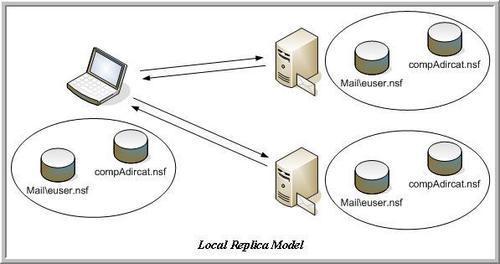
Implementing local replica-based mail allows users to access databases on the workstation without requiring a connection to a Domino server. This approach provides advantages for users who are connected over a wide area network or a virtual private network, since the operations of sending and receiving mail happen without the user noticing. By performing these operations in the background, slight errors in network communication will not be known to the user. Since new messages are kept locally until sent, there will not be any hang conditions in the Notes client when a server connection is slowed or lost.
For the consolidated environment, Notes clients will be configured to connect to a primary and secondary email server at the closest geographic site. The local replication model will be used and new messages will be synchronized with the servers in a high priority replication interval of 5-10 minutes. Addressing services will be provided by a condensed directory replicated to the local Notes client on a normal replication cycle of 30-60 minutes. Applications will be replicated following the normal replication cycle. Notes 8 clients will use the integrated instant messaging services linked to a clustered Sametime instant messaging server.
The desktop policies include a section that allows you to set and enforce replication on end users' workstations. In previous versions of Notes/Domino, there was no way to set and/or enforce replication to the end users desktop. This allowed some users to disable replication or set the replication threshold at one minute or less.
The following diagram outlines the replication settings available through the desktop policy. All options have the new How to apply this setting feature to enhance the setting of standards throughout the environment.
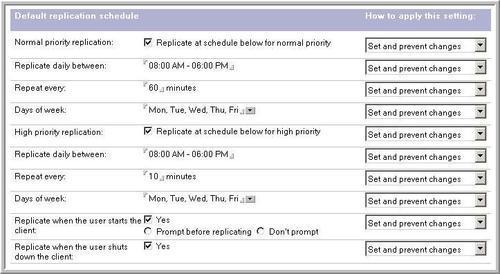
The security policy settings document has been enhanced to allow administrators to better manage Notes and Internet passwords, configure password polices, set up key rollover, and manage administration execution control lists (ECLs). In addition to these features, the security policy document in Domino 8 has been enhanced to account for the installation of Eclipse-based plug-ins. There are three options that can be configured within the security policy document within the Signed Plug-in tab, as noted below. Each option has the ability to be configured with the options as noted: Ask the user, Never install, and Always install.
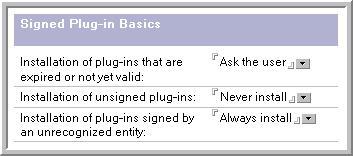
There are a number of other new and enhanced features within the policies environment. Refer to the Domino 8 Administrator Help for more information about this and other topics.
In previous releases of Notes/Domino, when the administrator moved or deleted a database, it was sometimes difficult to have end users redirect their links to the new location or (in the case of deletion) shift them to a replica. To address this, Domino 8 introduces a new feature called database redirect.
To redirect a database that is being moved, open the administration client and select the database in the Files tab. Then in the right pane select Database | Move.
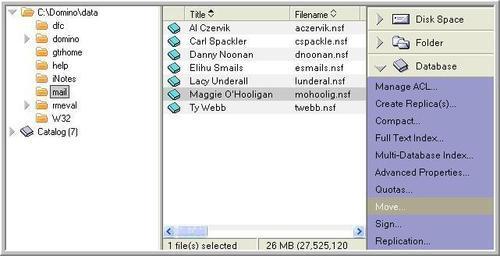
Select the servers to which you want to move the database, and select the directory in which the databases should be placed. In the right-hand pane, select the server, and in the lower right-hand section select Create a redirect marker for updating client references. This creates the redirection after the administrative process completes the move.
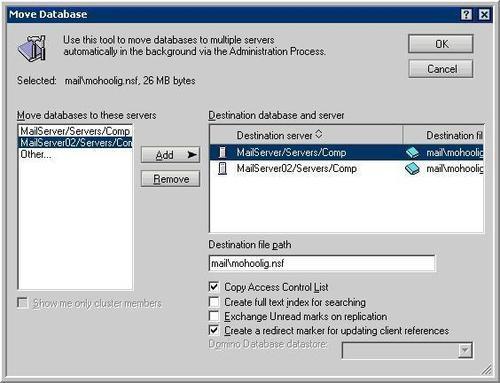
In the administration client Files tab, select the database to be moved. Then, in the right pane, select Database | Delete.

In the dialog box, select the Create a marker that allows clients to update their references to this database option.

Then choose the server to which users will be redirected to access the database. This is very useful when deleting a database on a specific server where the end user population is known.
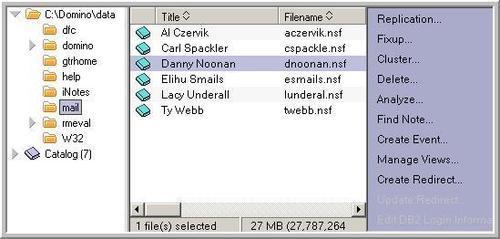
You can then move users to a replica on another server so as to help balance the load within the environment. When the following dialog box is presented, click Add to select the replica to which users are to be redirected.
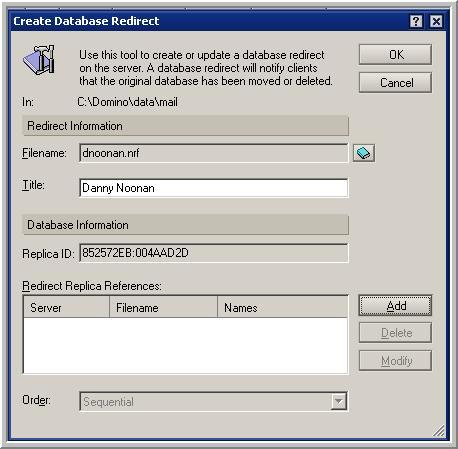
When selecting the database for redirection, you have the option of selecting which users should be redirected to the replica of the database. (This is an optional step in the redirect process.)
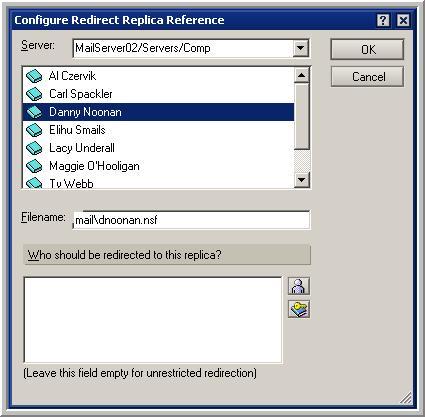
In this chapter, we have examined a number of important Notes/Domino 8 features that can make rolling out your new deployment significantly easier. We discussed client provisioning, including Eclipse-based client and server provisioning functionality. We also looked at policy enhancements and the new database redirect feature.
